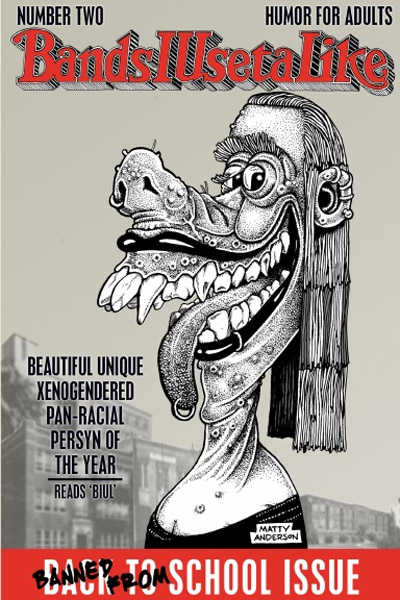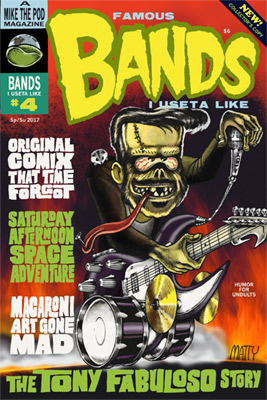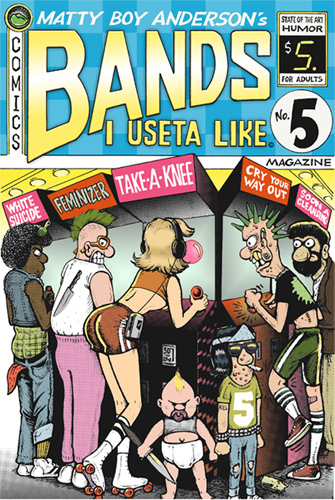It’s a modern fallacy that the oeuvre of Don Van Vliet, more commonly known to the world as Captain Beefheart, is impenetrable. As with many worthwhile pursuits, the point of introduction is crucial. Most people who bristle at Beefheart simply haven’t been ushered in the right direction.
Captain Beefheart and Frank Zappa were high school buddies with a shared love of R&B, in particular Howlin’ Wolf, whom Don loved to imitate. Don had a girlfriend named Laurie, whom his pervy uncle would sexually harass by flashing her as she walked past the bathroom; he would squeeze the end of his schlong and muse “ah, look at that. Looks like a big, fine beef heart.” Thus, a legend was born.
My own introduction to Captain Beefheart came in the form of 1980’s Doc At The Radar Station.

Vliet was a painter, which he retired to later in life, and this is one of the only albums to feature his art on the cover. In my opinion, this is a terrific starting point for anyone considering getting into the Captain. It covers the bases of his general sound, as well as his own poetic inclinations. And Beefheart sounds fantastic for a man who wouldn’t record in the studio with the rest of the group, but would only sing along with the audio leakage in the mixing room. (More on that later.)
The back cover of the album features a group shot of the band where they look like the most awesome bunch of science teachers ever.
“Hot Head” kicks off the disc with a nice, greasy guitar lick, before the Captain starts his unique vocals, and the beat drops. Before you know it, all the elements are in place. This album features some of the tightest production of his discography, and Beefheart is right where he should be in the mix. “Ashtray Heart” is an even more solid rocker with incredible, bursting energy. Here Beefheart applies a different voice, a hoarse, throaty howl he uses again on side two’s stellar “Telephone”.
Track 3 is one of my all-time favorites; a wistful instrumental with the lovely title of “A Carrot Is As Close As A Rabbit Gets To A Diamond”. This is a song to get your dad into Beefheart with, and frankly I’m surprised it’s never been licensed for a montage in one of those dramedies where people come to terms with things.
After this the tempo picks back up until the last three tracks. The entire album is solid, and full of hidden joys to discover. Intermittently, there are strings, courtesy of Eric Drew Feldman’s synthesizer, and to me they resemble the sounds the mind phases through during sleep deprivation. This association would be a propos, as it turns out.
The most challenging Beefheart disc for most listeners is undoubtedly 1969’s Trout Mask Replica. The only reason it should intimidate you is because it’s one of the most historically important albums ever recorded. Twenty-eight tracks over four sides, covering blues, free jazz, sea shanties and more. It’s a lot to take, and as Matt Groening can tell you, on first listen it is almost indistinguishable from madness.

Featured is one of Vliet’s best poems, “Orange Claw Hammer”. The tale of a sea-faring man who returns to the daughter he abandoned, every line rings with truth and aching beauty:
Uh thick cloud caught uh piper clubs tail
The match struck blue on uh railroad rail
The old puff horse was just pullin’ thru
‘n uh man wore uh peg leg forever
I’m on the bum where the hoboes run
The air breaks with filthy chatter
Oh I don’t care there’s no place there
I don’t think it matters
My skin’s blazin’ thru
‘n my clothes in tatters
‘n the railroad looked
Like uh “Y” up the hill of ladders
The Trout Mask version is a straightforward recitation, but Zappa, who produced the album, also did this radio version with Beefheart that I find to be the most perfectly realized.
“A beautiful sagebrush jackrabbit” always makes me catch my breath, and Vliet’s emotions as the song builds to its climax are truly affecting. And this is just one in a 28-piece set.
Just off the top of my head: “Dachau Blues” is one of the first times you get to hear just how low Don could go, “Moonlight In Vermont” is a rousing stomper, “The Blimp (mousetrapreplica)” is a hilarious dada recitativ over a telephone, “Veterans’ Day Poppy” closes things out beautifully, and there’s about 20 other songs worth discovering. I don’t want to beat you over the head with how important this all is, but you must admit it’s bold stuff for 1969.
In 1970 the boys followed it up with Lick My Decals Off, Baby. I consider it equal to Trout Mask Replica; some people argue it’s superior. I wasn’t crazy about it on the first spin, but came to adore it, especially for tunes like “Woe-Is-Uh-Me-Bop”. Check out the primal feel of the percussion, and can you believe a man’s voice could be this deep?
There are three instrumentals on this album (“Peon”, “Japan In A Dishpan”, “One Red Rose That I Mean”), all fantastic. The rest of the disc is no slouch, either, and again there’s lots to pore through. “Space-Age Couple” is a real highlight from the end of side two: “Space-age couple, why don’t you flex your magic muscle?”
The next entry, Mirror Man, is recordings from 1967 that are more straight-ahead psychedelic R&B, as was the style of the time. The Spotlight Kid is a decent album marred by growing tensions within the group. “I’m Gonna Booglarize You Baby” and “Click Clack” are tuff, chonking standouts. That same year (1972) Beefheart cut Clear Spot, which is paired with the previous album on CD releases. None other than Jeff Lebowski listened to this while checking his messages in his eponymous film, and it’s a track I can totally see him enjoying: the sublime “Her Eyes Are A Blue Million Miles”. However, I find the bluesy “Too Much Time” to be even better:
If you like that, you’ll love “My Head Is My Only House Unless It Rains”, “Sun Zoom Spark”, and “Big-Eyed Beans From Venus”. The experimentation is more subdued, but the results are surprisingly warm and almost radio-friendly. This is unfortunately a grim omen of things to come.
The following albums, Unconditionally Guaranteed and Bluejeans & Moonbeams (both from 1974), were an intentional grab at commercial success that failed so epically, the Magic Band actually fired Beefheart. I know of no good songs on the first one, and the closest the second gets to average is the title track. If I’ve convinced you to become a slavering Beefheart devotee, and one day you have absolutely nothing better to do, maybe give these a spin. Maybe.
In 1975 Vliet guested on Zappa’s Bongo Fury, performing idiosyncratic vocals written for him by Zappa. This got his image back in decent standing, and by 1978 he’d returned to form with the indomitable Shiny Beast (Bat Chain Puller). That’s right; an album so magnificent, Kurt Loder took the title of his book from it. Kurt Loder. Needless to say, this is another fine jumping-in point.
For example, listen to the title track. Do you hear that weird, off-beat guitar line throughout? It’s inspired by the sound of a car’s windshield wipers.
The only two stinkers on this disc are “Love Lies” and “Suction Prints”; everything else is brilliant. Side one kicks off with “Floppy Boot Stomp” and “Tropical Hot Dog Night”, two of the best songs in Beefheart’s entire catalog. “Owed T’Alex” is on par with “Orange Claw Hammer”, a colorful exploration of a time when people communicated more formally, by post. I heard it on a vinyl reissue at my friend Spencer Pope’s house and the interplay between guitars was much warmer and clearer than on CD.
Oh, man is that ever sweet. This was a reformed incarnation of the Magic Band, after Beefheart alienated the preceding group four years earlier. Unfortunately, Zappa’s manager Herb Cohen funded the production with Zappa’s royalty checks, ending their relationship and tying up the album for years. Two years later came Doc At The Radar Station, which I covered earlier, and then in 1982, the swan song; Ice Cream For Crow.
A haggard-looking Beefheart appears on the cover, the last decade having taken its toll. In his autobiography, Zappa describes seeing Vliet around this time in a state of near-destitution. Beefheart would tour with a shopping bag containing his most precious possessions; sketchbooks, his saxophone, etc., and routinely misplace or leave it behind. He had never been comfortable in front of an audience (once during a show, he had an anxiety attack and walked backwards off a ten-foot riser), and when on stage with Zappa, he seemed happiest while painting, rather than performing.
As if to defy all this, the third track, “Semi-Multicolored Caucasian”, is an anthem of youthful exuberance. Gary Lucas and Jeff Moris Tepper unleash a garden of springy, wriggling guitar notes, adding a unique fluidity. Have a listen to this last of Beefheart instrumentals:
Maybe it’s because I’m writing this on Halloween, but this album does have a seasonal feel to it; note the songs “Skeleton Makes Good”, “The Witch Doctor Life”, and “The Host The Ghost The Most Holy-O” (GREAT tune). The title track starts things off right, and how could anyone not love it after seeing this early music video?
MTV rejected that for being “too weird”; they were as stupid then as they are now. Weird is precious and good. True weirdness, twice as much.
Captain Beefheart was too weird to live. He retired after this album, to somewhere he could see the whales swim by, according to Zappa. He rode out his days painting, which he’d always loved, until the ravages of multiple sclerosis took him away. He walked away from one of the most important (if not lucrative) musical careers of the 20th century, leaving behind hours of aural treasures spanning back to the early 1960s. His influence on musicians that came after is immeasurable, and his name is trumpeted by the likes of Tom Waits, Laurie Anderson, PJ Harvey, David Byrne, DEVO and Frank Black, just to name a few. Whatever his faults, Captain Beefheart was an unrelentingly original artist, and one without equal.
Also, when he and Zappa were teenagers, they recorded a song about being stuck in a toilet when a poo floats by. It’s from the late 1950s, and may possibly be the earliest recording of the word “motherfucker”.











You must be logged in to post a comment.